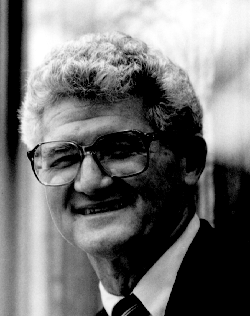
Spring/Summer 1999
Volume 6, Issue 2
Spring/Summer 1998
Volume
3, Issue 1
January 1995
Volume
2, Issue 4
October 1994
Volume
2, Issue 1
January 1994
EAC FOCUS
Peter Lax
Professor of Mathematics and former Director,
Courant Institute, New York University
Member, CRPC External Advisory Committee
 A renowned mathematician who considers himself both applied and
theoretical in his approach, Peter Lax entered computing "on the
ground floor," he noted. "I was stationed at Los Alamos in the Army
during the last year of WW II. In 1949, after I got my Ph.D. from the
Courant Institute at New York University (NYU), I joined the staff at
Los Alamos National Laboratory for a year and returned as a consultant
almost every summer for a decade."
A renowned mathematician who considers himself both applied and
theoretical in his approach, Peter Lax entered computing "on the
ground floor," he noted. "I was stationed at Los Alamos in the Army
during the last year of WW II. In 1949, after I got my Ph.D. from the
Courant Institute at New York University (NYU), I joined the staff at
Los Alamos National Laboratory for a year and returned as a consultant
almost every summer for a decade."
"These were years of explosive growth in computing at the lab, faster than anywhere else. The intellectual leader there was John von Neumann, who had a vision of the role of computing in science and technology. He was also deeply involved in the details of the science and engineering applications, the programming, and the mathematical aspects of using computers. In particular, he was devising schemes for calculating flows with many interacting shocks. I took up this problem and did my first numerical experiment in 1952 on Los Alamos' MANIAC computer."
In 1954, Lax returned to the Courant Institute to join the AEC Computing Center created at NYU. "The Atomic Energy Commission placed a UNIVAC at NYU, stimulating great interest in computing at the Courant Institute," he said.
Lax has spent the remainder of his professional career at NYU, making significant contributions to both mathematics and computing. He has written several important published works and has received numerous honors including the National Medal of Science, the Lester R. Ford Award, the Chauvenet Prize, the Semmelweis Medal, the Wiener Prize, and the Wolf Prize. Several students he has mentored have become leaders in the computing field.
However, among his most important contributions to the High Performance Computing and Communications community was his leadership on the National Science Board from 1980 to 1986. "In the 1970's, the government failed to make supercomputers available to university scientists," he said. "The Lax Panel, which I chaired, recommended that the NSF rectify this grave omission, leading to the establishment of the NSF's five national computing centers as well as the NSFnet." This development helped to spur the birth of the HPCC program in general and the CRPC in particular.
Regarding the importance of computing in the study of mathematics today, Lax once remarked in the book More Mathematical People, "Computer simulations play a big role [in mathematics]. After all, the great mathematician G.D. Birkhoff believed all his life that the ergodic hypothesis was true and devoted much of his life to studying it. If he had been able to take one look at a computer's simulation, he would have seen that it wasn't so."
Table of Contents